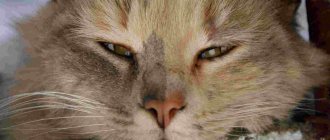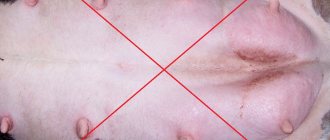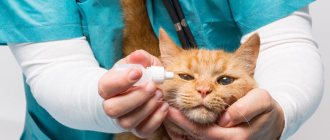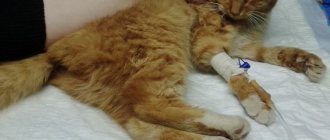Eye injuries in animals - a fairly common occurrence. Any eye injury is accompanied by severe pain. Sometimes the animal does not even allow you to touch the injured eye, and in some cases even the head. It should be taken into account that with such behavior of the animal, you should not try to examine the eye or force it open. In this case, you risk only aggravating the situation, because only a specialist can assess eye damage in dogs and cats, as well as its degree. That is why we recommend that you familiarize yourself with general information and the main symptoms that occur with eye injuries, and if you suspect damage to your animal, immediately seek advice from a veterinarian.
Blood in the cat's eyes
In veterinary practice, blood in one or both eyes of a cat is called hyphema. This pathology is otherwise called blood-red ophthalmic disease (eye disease). The pathology manifests itself in cats of different ages, regardless of breed. Characterized by bleeding into the anterior chamber of the organs of vision.
Important! Note that the intraocular fluid is normally colorless. Its main function is to ensure absolute transparency in the optical environment.
This is interesting: Cat with a squirrel tail
Diagnosis and treatment
First of all, the veterinarian will urgently try to determine the nature and severity of the injury received by the sick animal. This can be done using either a simple collection and analysis of a medical history or a number of specialized tests.
A high-quality examination of a sick animal is very important. It is imperative to check whether the animal has a closed craniocerebral injury, fractures of the facial part of the skull, whether the intracranial sinuses are damaged (this risks the cat simply choking on blood) and the jaw. If there are signs of other injuries (the animal fell from the balcony, resulting in damage to more than just the eye), the cat should be urgently sent for a more detailed examination. They also immediately find out whether a penetrating or non-penetrating injury is dealt with in a particular case. This information helps determine the prognosis.
And only after this can you completely switch to examining the affected eye. So, to identify possible corneal lesions, special staining is used. When special compounds are applied, ulcerative lesions begin to glow brightly in ultraviolet light. If in a particular case the veterinarian has any doubts, he can send the cat for a separate examination by an “animal” ophthalmologist. Other research methods:
- In severe cases, when an eye injury is caused by an animal falling from a height or being hit by a vehicle, it is strongly recommended that an examination be carried out by a veterinary neurologist.
- An X-ray of the skull is required to identify possible fractures and other damage to its internal structures.
- If the animal's eyes are too cloudy for visual examination, or the veterinarian suspects that the injury has damaged some structures directly behind the eyeball, an ultrasound examination of the entire affected area is prescribed.
- Computed tomography (CT) or magnetic resonance imaging (MRI) is indicated in all cases where eye injury occurs as a result of severe head impacts.
Diagnostics
The diagnosis is made based on a thorough examination, analysis of clinical signs, medical history and laboratory tests. Under no circumstances should you try to find out on your own the reason that provoked the appearance of purulent discharge from the eyes, and even more so you should not treat the disease without the help of veterinary specialists.
We recommend reading: Inflamed anal mucosa in a cat after constipation
Purulent discharge must be sent for examination to the laboratory to determine the infectious origin and test for sensitivity to antibiotics.
Treatment of purulent discharge consists primarily of eliminating the cause that caused the pathological process to begin. The purpose of treatment will depend on the correctly identified cause:
- If the cause of the appearance of pus is a bruise, then this area is thoroughly cleaned using gauze swabs soaked in a 3% solution of hydrogen peroxide. This must be done quite carefully so as not to further injure the conjunctiva. Then the eye is washed with a solution of potassium permanganate and eye drops with antibiotics are instilled.
- In case of eyelid injuries, proceed in the same way as in the treatment of bruises.
- In case of blepharitis, the cause is immediately eliminated. The cat is placed in a clean, well-ventilated room. A balanced diet is also important, since sometimes blepharitis can be caused by vitamin deficiencies. If there is a gluing of the eye with dried crusts of pus, they are softened with Vaseline oil. After this, they are removed with a swab soaked in a 3% hydrogen peroxide solution. The eye is washed with furatsilin and eye drops are instilled. You can also use eye ointments. In case of severe pain, 0.5% novocaine with an antibiotic is injected into the conjunctival sac. In cases where the process penetrates into the deeper layers of the eye, general antibiotic therapy is indicated.
- For purulent and phlegmonous conjunctivitis, general and local treatment is carried out. The eye is washed 2-3 times a day with a 3% aqueous solution of boric acid, after which 5-10% syntomycin emulsion or any other eye ointment with antibiotics is placed under the lower eyelid. It is advisable to carry out anesthesia, for which a special novocaine blockade with an antibiotic is placed, which also has a therapeutic effect. Antibiotics are administered intramuscularly, and sulfonamide drugs can be given orally.
Thank you for subscribing, check your inbox: you should receive an email asking you to confirm your subscription
As a rule, any eyelid injuries are accompanied by damage to the conjunctiva. Foreign objects that get inside irritate the mucous membrane of the eye, causing inflammation. The danger of such damage is that foreign bodies can affect the sclera and cornea, opening the gates for the penetration of pyogenic infection.
Reasons for the development of hyphema
A number of factors contribute to the development of hyphema in cats and other domestic animals. Among the possible reasons that provoke hemorrhage in the eye are:
- increased intracranial blood pressure (systemic hypertension);
- chronic, in rare cases acute pathologies, diseases of the organs of vision;
- various eye injuries;
- foreign objects in the eye;
- benign, malignant, metastatic formations (neoplasia);
- endocrine pathologies (diabetes mellitus);
- conjunctivitis of various etiologies;
- inversion of the eyelids (entropion);
- genetic, breed predisposition;
- chemical, thermal burns of the eyes;
- systemic diseases;
- head injuries;
- poisoning by poisons, toxins, chemicals;
- chronic cardiovascular pathologies;
- inflammation of the lacrimal sacs of a non-infectious nature;
- complications after ophthalmological operations;
- past viral and bacterial infections.
Important! Redness in both eyes is often caused genetically. Burmese cats, Siamese cats and their crosses are at risk.
Hemorrhage and red eyes are noted in cats with dry eye syndrome. With this pathology, insufficient hydration of the cornea and conjunctiva is noted.
Age-related changes, chronic kidney disease, intoxication, allergies, ophthalmological problems (corneal ulcer, keratitis, strabismus, retinal detachment) can also cause hyphema in cats.
Types and symptoms of eye injuries
Penetrating trauma
Occurs when sharp objects enter the organ: wood or metal sawdust, glass. And also a scratch appears as a result of a fight with relatives, incorrectly performed toilet of the eyes with poorly filtered herbal infusions. A cat can accidentally touch its eye with its claw while washing its face or, while playing, stumbles upon a sharp piece of furniture. Most often the cornea, lens, sclera, and choroids are damaged. Symptoms:
- redness and swelling;
- profuse lacrimation;
- soreness;
- unnatural squint;
- bleeding
Concussion injury
- severe pain, the animal meows;
- swelling and hyperemia;
- displacement of the eyeball;
- tearfulness;
- swelling of the eyelids, causing the eye to be half closed;
- bleeding;
- corneal clouding;
- lack of appetite;
- depressed state.
Chemical injury
- severe pain, the pet screams;
- rushing around the room in pain;
- aggression;
- the cat shakes his head;
- cardiopalmus;
- bleeding and swelling of the eyelids;
- clouding of the eye structures.
In case of eye damage
In this case, veterinarians recommend using Diamond eye drops. They are used when it is necessary to remove dried exudate in the corners of the eyes, after injury to the eyes by foreign bodies, with excessive lacrimation, in case of inflammation of the mucous membrane, and with “red eye” syndrome. They are dripped 1-2 drops up to three times a day until complete recovery.
To prevent your pet from scratching its eyes, further injuring them, we recommend putting a protective collar on it.
Protective collar
In addition, it is very useful to wash your cat’s eyes with chamomile infusion (not tea). And behind the lower eyelid you can put tetracycline eye ointment.
So, if you notice that after a fight your mustachioed fighter’s eyes are watery and this brings him discomfort, use our tips.
Eye contusion or blunt trauma to the eye in a cat
Eye contusion is a condition that can easily be caused by a fist fight. And a bruise to boot. As you know, cats usually fight with their paws, not their fists, but this does not prevent them from receiving concussion injuries to the eyes. In addition, injury can be caused by any blunt object: a rubber ball, the corner of a door, etc. When struck with a blunt object, the eye is deformed for some time and then returns to its original shape. Depending on the degree of deformation, either simple inflammation, or intraocular hemorrhage, or rupture of eye structures with serious consequences may develop.
Just like with a claw injury, it is very difficult to understand how serious the eye injury is in a cat. Externally, they can be almost identical. But in one case everything will go away on drops, and in the other the eye will be lost.
That is why treatment of an eye injury in a cat begins with getting the patient to the doctor as quickly as possible. I recommend that any cat with an eye injury see a veterinary ophthalmologist as quickly as possible. Despite being busy, staying at the dacha or other reasons. Find time for this. Otherwise, it makes sense to immediately accept the idea that the eye can be removed.
This is interesting: Is it worth getting a cat?
Eye wash
The washing procedure itself does not require special skills and knowledge, but you should consult a veterinarian about the product. Otherwise, the condition will only worsen, and this will lead to the progression of the disease. Often use regular saline solution, boric acid or herbal decoctions.
Washing the cat's eyes
Healthy! You can buy ready-made solutions in pharmacies.
We suggest you read: Why aquarium fish die
When severe consequences occur from cat bites and scratches
The degree of danger of cat bites depends on the depth of damage to soft tissues and the infection that enters the wounds from the claws and teeth of the predator.
Any cats, not only homeless ones or those living on personal plots and spending most of their time outside their homes, while on the street rummage in the sand and earth, chase and kill rodents, birds, large insects, and dig in garbage heaps. In this case, many pathogenic microorganisms are obtained that stick to their fur, claws and teeth, penetrate inside the cat’s body, and then are transferred to the wounds of people, causing suppuration and illness of varying degrees of severity.
People who suffered from animal attacks, who did not hesitate what to do if they were scratched by a cat, and immediately after providing first aid sought a professional examination, most likely avoided surgical interventions and long-term hospitalization, taking antibiotics, dressings, and rough scars from festering wounds. All this can happen if terrible diseases that beloved pets, like stray animals, can infect people with are not diagnosed in time.
Rabies and tetanus
The first and second places in terms of danger are shared by rabies and tetanus. Most people know about these diseases in some detail. They understand that if, after wounds received from unknown animals, one does not seek preventive vaccinations and vaccinations, then life can end in terrible pain and suffering.
Additional Information! Cats that often scratch people can wear silicone anti-scratch pads on their claws.
Felinosis
There is another little-known disease that does not cause death, but causes a lot of pain. It occurs after an animal violates the integrity of a person’s skin with its dirty claws. It is called “Cat Scratch Disease”, or Felinosis, and is determined only by the results of clinical examinations. The source of the disease is the Bartonella bacterium, which lives in the cat’s body, but does not cause harm to it.
But in people whose blood felinosis pathogens have entered, the lymph nodes become inflamed, rot, the temperature rises, and the sick feel severe ailments and weakness. Internal organs may be damaged - liver, kidneys, spleen, eyes, nervous system; rashes and painful swellings of the skin over the inflamed lymph nodes may appear on the skin.
This disease is treated with antibiotics, and sometimes goes away without complications. The treatment period is long - from 3 to 6 months. During this period, the scratches through which the infection entered the human body will heal, and the person will continue to suffer.
Determining the severity of the pathology
It is important to understand that an eye swollen with blood and bleeding from the conjunctival cavity are completely different phenomena, of varying degrees of severity. If a small amount of bloody exudate simply flows out of the eye, then there is no particular reason to panic. But in situations where the cat's eye resembles a blood globule, it is necessary to show the pet to the veterinarian as soon as possible.
As a rule, eye diseases accompanied by the appearance of bloody exudate are quite easy to treat. Pathologies that turn the eyeball into a bloodshot sphere almost always lead to blindness of the animal. In addition, it is necessary to contact the clinic as soon as possible if the following signs appear:
- Small red dots appeared on the surface of the eye.
- Some pets develop thin reddish stripes on their corneas.
All these signs may indicate the initial stages of a pathology called “hyphema.” If you do nothing, the dots and/or stripes will gradually merge, the eye will fill with blood, as a result of which the cat will go completely blind.
First signs of injury
One way or another, the fact remains that the eye is injured and it is absolutely unacceptable to take this lightly, especially if the cat scratched the child’s eye. With such an injury, the cornea of the eye is the first to suffer. Despite the fact that a cat scratch on the cornea is not as dangerous as, for example, a burn or penetrating injury (although, unfortunately, sharp cat claws can cause such severe injury), it should never be ignored. A scratch in the corner of the eye, however, as in any other place on the cornea, causes severe discomfort, although it has virtually no effect on vision.
Foreign bodies
Foreign body entry is one of the most common causes of eye injury. Dogs are especially susceptible to this during active walks in the forest or just in tall grass.
Fragments of thorny plants dig into the conjunctival sac or into the cornea of the animal's eye. In this case, the pet experiences severe pain and may try to get rid of the splinter on its own, thereby further irritating and injuring the visual organ. Eye rinsing can serve as an emergency method for an animal in such situations. This can be done with saline solution (sold in any human pharmacy) or boiled water.
Causes of bleeding from the eyes
Most often in veterinary practice, specialists encounter the following causes of “bloody eyes”:
- Eye injuries. Blood will definitely ooze from deep scratches and abrasions.
- Contact with foreign bodies in the eyes. Large particles of sand, glass or other debris will certainly scratch and injure the delicate mucous membranes of the organs of vision.
- Advanced forms of conjunctivitis (especially purulent). In this case, the capillaries of the conjunctival membrane may be destroyed, resulting in bloody or even bloody discharge from the eyes.
- Blepharitis, inflammation of the eyelids. If the process has affected the inner surface of the organ, then bloody discharge will also appear from the eyes.
- Ulcerative keratitis , i.e. inflammation of the cornea, accompanied by ulcerations of the surface of the organ. In this case, the cornea may bleed.
- Turning of the eyelids. In this case, the cornea is scratched and the eyelashes are damaged, as a result of which the eye begins to bleed.
Types of tinctures and solutions
Eye solution can be purchased at a pharmacy or prepared independently.
The most effective are:
- Camomile tea. Dilute one tablespoon of dried flowers in a glass of boiling water. Leave for 30 minutes.
- A decoction of strong tea. It is advisable to use whole leaves and distilled water.
- Table salt solution. For a liter of distilled water, take 1/2 teaspoon of salt. The mixture is brought to a boil. Not suitable in case of an allergic reaction.
- Lacrimin or Medkinos solutions, which can always be purchased at a pharmacy at an affordable price.
An experienced owner always pays attention to the behavior of his pet. Symptoms:
It is recommended that you familiarize yourself with the questions that cat owners most often ask when pus appears in the eyes, so that you know what you have to deal with in practice.
The cat has a festering eye and nose, sneezing, runny nose
One of the reasons for sneezing, runny nose and purulent eyes in cats can be a cold. It is necessary to treat a cold animal by creating greenhouse conditions for it and improving its diet. Warming the nasal area with hot salt or sand wrapped in a piece of cloth and instilling a 1% soda solution into the nose helps eliminate a runny nose and sneezing. In the fight against conjunctivitis, eye drops and ointments are effective - sofradex, tetracycline, chloramphenicol. However, it will be much better if you hear such recommendations from the lips of a veterinarian.
The cat's eye is festering and does not open, the eyelid is swollen
If a cat’s eye is festered and cannot open, or the eyelid is swollen, then there is a high probability of a foreign body getting into the eye, which means that professional intervention is indispensable. Every hour of delay can result in deterioration of vision or its complete loss.
We recommend reading: Is it possible to feed kittens with store-bought food?
The cat's eye is festering, swollen and red, his cheek is swollen, what should I do?
The diagnosis of the disease with such serious symptoms can only be made in a veterinary clinic where there is special equipment. The cat may need to have an x-ray, an MRI, or a needle biopsy taken. To prevent the cat from scratching the tumor, it is necessary to wear a collar.
A cat's eye is festering after a fight, from birth what to treat and rinse, drip
Suppuration of a cat's eyes is often caused by a bacterial or viral infection, so curing only the external manifestations of the disease can only worsen the general condition of the animal. The nature of the disease is established after taking swabs from the conjunctiva. Based on the test results, the most effective treatment path will be chosen. When providing first aid to an animal, you can wash the eyes with a cotton swab dipped in solutions of furatsilin or pale pink manganese.
A cat's eyes are festering, treatment and how to treat it, what to apply at home
To treat purulent eyes, prepare a washing solution - dilute manganese to a pale pink color or furatsilin (1 tablet per 100 ml of water). The eyes are treated separately, each time using a new gauze swab (vyta fibers can cause additional irritation to an already inflamed eye). Direction: from outer corner to inner corner.
To apply eye drops, the animal is laid on its side and its head is turned up. All you have to do is gently hold your eyelids and drip in 2-3 drops of the medicine prescribed by your doctor.
The cat's eyes are festering, treatment with folk remedies
The most common folk remedy for eye suppuration is a decoction of the herbs chamomile, eyebright, calendula, or pharmaceutical hydrocortisone or tetracycline ointment,
The cat's eyes are festering, what drops to buy, tetracycline, albucid, antibiotic, chloramphenicol, sulfacyl
In principle, the listed medications - tetracycline, albucid, chloramphenicol and sulfacyl - are suitable for the treatment of suppuration in the eyes of a cat. To which of them the viruses and bacteria that cause the disease will be more sensitive, conclusions can only be drawn by analyzing the conjunctival wash.
The cat has festering eyes, does not eat or drink anything, is lethargic for a very long time, has no appetite, how to cure it
A panacea for all diseases has not yet been found, either for animals or for people. Symptoms when a cat’s eyes fester, he doesn’t eat or drink anything, is lethargic for a very long time, has no appetite, accompany many infectious and chronic diseases, which means a visit to the animal clinic cannot be avoided.
Why does a cat's eyes fester, causes, worms after injury and what to drip
The reason that a cat’s eyes are festering may be: - mechanical injury or bruise; - reaction to irritation by acids or toxic fumes; - disease caused by infection or helminths; - damage to the conjunctiva and penetration of pathogenic microorganisms into it; - an inflammatory process that affects areas adjacent to the eye. Instilling eye drops even with the best drug will not give the expected effect until the root cause of the disease is eliminated and cannot be done without the help of a veterinarian. Only a doctor can tell you what to drip in each specific case.
The cat has white pus in his eyes, how to help
If a cat develops purulent discharge from the eyes, the animal should be immediately shown to a veterinarian. As a first aid, you can wash your cat’s eyes with a chlorhexidine solution of 0.05% or with plain boiled water, and then drop a couple of eye drops - “Iris”, “Diamond Eyes” or “Leopard”, and blot the fur around the animal’s eyes dry with a napkin.
Is it possible to wash the cat's eye with chlorhexidine?
Chlorhexidine is a cheap and effective drug with an antibacterial effect. To wash the eyes, use a 0.05% aqueous solution of the drug. Note the difference - chlorhexidine is used as a rinse rather than as an eye drop. Those. A cotton swab is generously moistened in the solution and rubbed over the hair around the eyes in order to soak and remove dried purulent crusts.
A cat's eyes are festering, can a person become infected?
Purulent discharge from a cat’s eyes is a symptom of various diseases of a parasitic or infectious nature, so the possibility of human infection with them cannot be ruled out.
Suppuration of a cat's eyes is often caused by a bacterial or viral infection, so curing only the external manifestations of the disease can only worsen the general condition of the animal. The nature of the disease is established after taking swabs from the conjunctiva. Based on the test results, the most effective treatment path will be chosen. When providing first aid to an animal, you can wash the eyes with a cotton swab dipped in solutions of furatsilin or pale pink manganese.
In animals, most inflammatory diseases of the eye are accompanied by the release of purulent or mucous exudate from the conjunctival cavity.
Why does an animal's eye fester?
The discharge of pus from the eye in animals is associated with the proliferation of pathogenic microorganisms in the conjunctival cavity. Under the influence of waste products (toxins) of microbes, the pores of the walls of blood vessels expand and immune blood cells (leukocytes), as well as the liquid part of the blood (plasma), enter the conjunctival cavity and form a mucous or purulent exudate.
Scratch on the eyeball: treatment
Minor scratches
Serious corneal injuries
If complex scratches occur that result in scalping of the corneal flap, the following actions are taken:
- anesthesia, the doctor uses special drops;
- it is treated with antibacterial drugs;
- the damaged flap is put back into place;
- re-instillation of drops;
- an antibacterial dressing is applied.
There are times when the flap cannot be put in place, then sutures are used. Monofilament fibers are used for this procedure. For example, nylon, supramid.
Your doctor may prescribe non-steroidal anti-inflammatory drops and soft contact lenses. This combination can easily replace a bandage. The victim will be able to see with both eyes, which receive oxygen. Therapeutic therapy will lead to rapid recovery of the cornea.
Hyphema
Hyphema is a pathological condition in which the anterior chamber of the eye begins to fill with blood. This is a very serious condition, since the fluid inside the eyeball is normally completely transparent. Its transparency is necessary so as not to interfere with the passage of light. If blood gets into the eye fluid, the light does not reach the lens at all, causing the animal to go completely blind.
The reasons for the development of hyphema are quite diverse:
- Injuries.
- Uveitis, iridocyclitis (inflammation of the eyeball itself and its vascular network).
- Various neoplasms.
- Systemic pathologies, including diabetes, blood clotting problems, autoimmune diseases, etc.
Degrees of hyphema development
The symptoms of the disease are quite simple: the eye is completely filled with blood, in severe cases it looks like a cherry. In addition, we already recalled above that the initial stages of hyphema may be accompanied by the appearance of small red dots or stripes on the surface of the eye.
All this depends on the specific stage of the hyphema:
- There are dots or stripes on the surface of the eye, up to ¼ of the eye chamber being filled with blood.
- The second stage is from 1/3 to ½ filled with blood.
- In the third stage, the eyeball is more than half filled with blood.
- The eye turns into a “blood ball”, the gaps are completely absent, the animal goes blind.
Treatment of hyphema in cats
Since hyphema is not a disease itself, but only a consequence of some pathology, the veterinarian’s goal is to quickly identify the root causes of what is happening and neutralize them. As for the hyphema itself, unfortunately, specific treatment has not yet been developed for it. Therefore, specialists resort to combined, complex therapy:
- Corticosteroid-based medications are required. They are needed to relieve inflammation and pain.
- Vikasol and other drugs that improve blood clotting are used.
- Vascular strengthening compounds are prescribed (Venarus, Troxevasin, etc.).
- Because some underlying causes of hyphema are accompanied by severe pain, sedatives and pain medications may be required.
- Be sure to prescribe atropine, as well as medications with β-blockers. They are required to stabilize intraocular pressure.
Prevention of eye diseases
Symptoms can be very different. An appropriate treatment must be selected for a specific disease.
Inflammation in the eyes of a cat
The first reason is etropion. Also called entropion. The edge of the lower eyelid bends inward, and the animal feels severe pain.
Important! If the volvulus is not treated in time, keratoconjunctivitis will develop.
Iritis (iridocyclitis)
Photophobia, yellow iris, constricted pupil are symptoms of inflammation of the iris. This disease is called iritis. Occurs due to bacterial infection, injury and metabolic disorders.
The third eyelid performs a protective function. If this protective device for the cat's eyes falls out of its boundaries, then foreign bodies, viruses or bacterial infections have entered the eye. Poisoning of the body and allergic reactions occur, and nervous disorders are possible.
Cataract
When the optical areas of the lens are affected, the cat begins to show symptoms:
- lethargy;
- poor orientation;
- blindness;
- pupil dilation
Because of this, the cat becomes fearful and sometimes aggressive. The eye may become completely opaque and a cataract will appear.
Cataract on the vitreous body
Conjunctivitis
As a result of conjunctivitis, redness and swelling of the eyelid develop, and the eye begins to water. The eyelids may turn out and movement of the eyeballs may be impaired. The disease occurs due to bacteriological effects on the conjunctiva that protects the eye.
The symptoms and causes of inflammation of the third eyelid are similar to those of prolapse. The eye begins to fester, and the kitten experiences severe discomfort.
Wounds of the eyelids
Pets may experience eyelid damage. This occurs due to mechanical damage from teeth, claws and other foreign objects that can rip off the eyelids. Inflammatory swelling and constant slight bleeding develop.
Blepharitis
Blepharitis is inflammation of the eyelids. It should not be confused with ordinary conjunctivitis. The disease most often occurs due to burns (including chemical ones), allergic reactions and mechanical damage to the cornea.
We suggest you familiarize yourself with: Red cat with green eyes
Against the background of blepharitis occurs:
- baldness around the eyes;
- the incision begins to rapidly decrease;
- redness appears;
- severe inflammation of the eyelid.
As a result, the pet's viewing angle is severely limited and disorientation appears.
Blepharitis in a cat
A small tumor, the size of a pea, appears in the cat's eye. Often white or bright pink in color. Benign origin does not guarantee safety, since the tumor leads to complete closure of the eye.
Dacryocystitis
The next cause of disease is inflammation of the nasolacrimal sac on the eye. A swelling appears at the site of the gland, and purulent mucous fluid often comes out of it. There is an increase in temperature and severe lacrimation.
Attention! This inflammation leads to the following problems: conjunctivitis, which provokes keratitis and a number of other diseases.
Panophthalmitis
Severe damage to the tissue of the eyeball. After staphylococci and streptococci penetrate into the eye, complete destruction of the tissues of the organ of vision from the inside develops. Within a few days, the animal’s health deteriorates sharply, and the organ begins to become severely inflamed.
Important! Appetite and sleep become poor, followed by fever and fever.
Keratitis
Inflammation of the cornea is called keratitis. The main symptom is corneal clouding of varying severity. Damage occurs due to deep eye injuries and external pathological influences
The curiosity of cats plays a cruel joke on them. If the animal squints, blinks frequently and rubs its eye with its paw, then a foreign object is stuck in the eye. This could be dust, grass, debris, sand, etc.
If this misfortune has befallen your pet, you should immediately consult a veterinarian. The organ of vision is examined and its general condition is assessed according to three parameters:
- appearance of the eyeball and surrounding tissues;
- general condition: size, shape, presence of injuries;
- state of vision.
After a superficial diagnosis, a study is carried out using special devices. The fundus of the eye is examined, the sensitivity of the microflora to antibiotics is determined, and the pressure inside is measured. A specialist may prescribe a biochemical blood and urine test.
Fundus examination by a veterinarian
To prevent your cat from having eye problems, you need to eliminate all the factors that lead to diseases. It is necessary to wash the cat's organs of vision with saline solution so that there is no excess secretion there. Carry out wet cleaning every day, otherwise the animal may get a foreign body that can inflame the eye. You can't disturb the cat, then it will be healthy.
There are many eye diseases in cats, so pets should not be stressed and need regular care. If you do everything correctly and love your animal, then no disease is scary.
*Prices are current as of September 2021.
We suggest you familiarize yourself with: Bivalves. Description, features, structure and types of bivalve mollusks
Main symptoms
Eye damage in cats can be traumatic, inflammatory, infectious or genetic.
- Blepharospasm, that is, closing or squinting of the eye. As a rule, it is a consequence of mechanical damage.
- Increased lacrimation. May be due to injury or illness.
- The appearance of unevenness on the surface of the eye. In most cases it is caused by a strong blow.
- Redness. Indicates possible injury, infection, inflammation, and increased eye pressure.
- Purulent discharge is a symptom of an inflammatory process, systemic disorders in the body, and the consequences of untreated damage.
- Enlargement of one or both organs of vision. Indicates increased eye pressure, lens dislocation, chronic renal failure, and genetic pathology.
- Partial prolapse of the eyeball. It occurs in brachycephalic cats with a flattened muzzle and is caused by the anatomical features of the skull.
- The appearance of a red swelling in the inner corner of the eye. Occurs against the background of diseases such as adenoma of the third eyelid or prolapse of the Gardner gland.
Types of conjunctivitis, causes and symptoms
This disease in cats can be bacterial, viral, fungal, catarrhal, allergic and follicular. It is divided into types depending on the source of the lesion. Each type of conjunctivitis is characterized by a specific clinical picture. To be able to determine the cause of inflammation of the conjunctiva, you need to know how each of the existing forms of the disease manifests itself.
Bacterial (purulent) inflammation of the eyes
The development of purulent conjunctivitis in cats and kittens is caused by various bacteria. This is far from the most harmless disease. You can recognize it by the following signs:
- discharge of purulent exudate from the affected organ - pus appears in the corners of the eyes, on the fur in the infraorbital region, on the eyelids, gluing them together;
- swelling of the eyelids;
- inflammation of the mucous membrane.
In severe cases of the disease, the animal’s body temperature sometimes rises. As it develops, purulent discharge becomes abundant, acquiring a yellow or green tint. Purulent inflammation of the conjunctiva can develop into keratitis, which can lead to complete blindness of the animal.
Viral form
This type of conjunctivitis is caused by various viruses. This type of disease can occur in acute or chronic form. In the first case, the pet’s eyes hurt and itch, tears flow profusely, the eyelids swell, and he rubs them all the time, trying to relieve the pain. Against the background of pathology, the animal’s appetite may deteriorate and digestive problems may begin.
Information about the most common causes of the development of this viral form of disease is presented in the table:
- discharge from the nose and eyes;
- inflammation of the lymph nodes (in advanced cases);
- apathy;
- hypersalivation;
- increased body temperature;
- ulcers on the tongue and palate.
- swelling of the mucous membranes of the eyes;
- ulcers on the tongue and gums, sometimes in the nasal cavity;
- acute pneumonia (in severe cases).
Fungal infection of the conjunctiva
The culprits of fungal infection of the conjunctiva of these domestic animals are pathogenic fungi. This type of conjunctivitis is a symptom of chronic infections such as actinomycosis, candidomycosis, and aspergillosis. This is a very complex form of the disease, the treatment of which requires considerable effort and time. A sick pet's affected eye hurts, swells and is very watery, it becomes lethargic and apathetic, and loses interest in food.
Allergic conjunctivitis
The clinical picture is somewhat different from the symptoms of other forms of inflammatory process in the conjunctiva. In this situation, eye swelling is absent or mild. An allergic reaction is manifested by the following symptoms:
- severe itching;
- redness and rashes on the skin;
- swelling of certain parts of the body;
- nasal discharge;
- sneezing;
- hypersalivation;
- breathing problems;
- deterioration of coat condition;
- vomit;
- increased body temperature;
- peeling of paw pads;
- eczema between fingers.
Follicular form
This form of the disease is considered the most severe and requires long and complex treatment. The inflammatory process in follicular conjunctivitis involves the mucous membranes of the eyelids and lymphatic follicles, which are located on the inner surface of the nictitating membrane.
Manifestations of this type of disease in kittens and adult animals:
- small red dots and a cloudy grayish film on the inner area of the eyelids, protrusion of their mucous membrane;
- discharge of purulent exudate;
- blepharospasm, i.e. involuntary contraction of the orbicularis oculi muscle, leading to persistent spasmodic closure of the eyelids;
- photophobia.
What causes fester in the eyes of a cat, cat, kitten: TOP reasons and how to treat
Purulent discharge from the eyes is a non-chronic infectious disease that has varying degrees of severity and occurs in many four-legged animals.
Suppuration does not occur normally; they indicate inflammation. For this reason, the first thing to do if your cat has festering eyes is to go to the vet.
Causes of pus in the eyes of cats
All causes of eye suppuration in cats can be divided into several large groups:
- Mechanical damage to the retina. Accompanied by temporary inflammation followed by watery discharge. The latter accumulate in the inner corners of the eye in the form of small, hard brown or black lumps.
- Chemical exposure that causes an animal to develop blepharitis (inflammation of the edges of the eyelids).
- Colds or allergies are often accompanied by clear or white mucous discharge from the nose and eyes.
- The body's response to the action of pathogenic microorganisms. The discharge is yellowish-green in color and is recognized by the specific smell of pus.
- The result of a complication of conjunctivitis that occurs when a veterinarian is not consulted in a timely manner.
- Helminthiasis. In addition to the main parasitic factor, helminths poison the animal’s body with the products of their vital activity. As a result, an allergic reaction occurs, accompanied by mucus from the nose and suppuration of the eyes.
We recommend reading the article about eye diseases in cats to understand the topic in more detail.
Symptoms
An experienced owner always pays attention to the behavior of his pet. Symptoms:
- Loss of appetite, general lethargy, increased sleep duration.
- Increased body temperature.
- Preference for dark, secluded places due to increased sensitivity to light.
- Squinting or closing your eyes most of the time.
- The presence of a specific odor.
- The appearance of a rare cough, redness of the mucous membrane, runny nose.
Diagnostics
If primary suppuration occurs, the owner should immediately contact a qualified specialist, preferably a specialist, an ophthalmologist. Time and strict adherence to the doctor’s instructions play an important role in the favorable outcome of treatment.
You should take eye diseases in newborn kittens especially seriously, because... complications later will pose an even greater danger.
Without laboratory tests and an integrated approach, it is impossible to be sure that the diagnosis is correct. Unfortunately, not all owners remember this, preferring self-medication at home to an experienced veterinarian.
Treatment methods
It is important to remember that the success of recovery directly depends on the accuracy of the diagnosis and the person’s willingness to fully comply with the instructions.
Recommendations:
- For a complete diagnosis, the doctor requires an anamnesis, i.e. information about the cat: what conditions the pet lives in, its diet, previous diseases, behavioral characteristics, proximity to other animals.
- It is advisable to wash your cat’s eyes with a warm chamomile solution before visiting the veterinary clinic.
- Depending on the causes of suppuration, the doctor may use several treatment approaches. In case of prolonged and profuse discharge from the eyes and nose, as a rule, a novocaine blockade with the administration of an antibiotic is prescribed. If discharge from the eyes is the result of mechanical damage, use Levomycetin drops for an adult cat or Albucid for one-month-old kittens.
List of recommended drugs
Based on the causes of the disease, the veterinarian most often prescribes the following medications:
- For bruises and injuries - drops of Levomycetin or Iris.
- For swelling - a solution of hydrocortisone and novocaine.
- For acute illness - intramuscular antibiotics.
Prescribing medications for an animal should only be done by a professional after a complete diagnosis. Self-treatment without the guidance of a veterinarian can lead to complications and irreversible pathologies.
Tips for beginners when washing eyes
Eye washing is one of the most important points in the treatment and prevention of disease in any animal.
You can do the procedure yourself at home or go to a veterinary clinic. During a period of illness, a cat is most often reluctant to allow its owner to approach it.
Representatives of the Persian, British and Siamese breeds are especially capricious. In this situation, it is advisable to ask a family member to hold the cat's head during the procedure. It is best to secure it with a towel or diaper.
Recommendations:
- A folded cotton pad or a tight tourniquet is suitable for rinsing. It is better to avoid cotton swabs, as they do not absorb liquid well, have a relatively small surface and can damage the retina when the animal tries to escape.
- For sterility purposes, it is better to prepare separate dishes for washing each eye. For the same reason, you should use a cotton pad no more than once.
- It is not recommended to touch the inflamed surface with a dry disc.
- Hands must be washed.
- All solutions must be at room temperature.
- Keep in mind that a swollen area can often cause pain for your cat.
- The best treatment is comprehensive. After rinsing with the solution/drops, re-treat the inflamed area with ointment.
- You need to repeat washing as often as possible. Step-by-step instructions for washing eyes
- Fix the animal on its side, turning its head up, holding the chin.
- If a crust forms and the eye sticks together, soften the inflamed area with Vaseline oil. Using cotton wool soaked in 3% hydrogen peroxide, remove the discharge, then rinse with the solution and apply eye drops.
- Apply the solution to the eyeball, gently lifting the eyelids.
- Raise and lower the animal's eyelids several times to distribute the medication evenly. Remove excess with a disc.
- Do not forget about nasal discharge, remove it with a cotton pad.
Types of tinctures and solutions
Eye solution can be purchased at a pharmacy or prepared independently.
The most effective are:
- Camomile tea. Dilute one tablespoon of dried flowers in a glass of boiling water. Leave for 30 minutes.
- A decoction of strong tea. It is advisable to use whole leaves and distilled water.
- Table salt solution. For a liter of distilled water, take 1/2 teaspoon of salt. The mixture is brought to a boil. Not suitable in case of an allergic reaction.
- Lacrimin or Medkinos solutions, which can always be purchased at a pharmacy at an affordable price.
Choosing eye drops
Unlike infusions, it is impossible to prepare drops at home. You can find the necessary remedy at a veterinary or regular pharmacy.
It is important to remember that neither solutions nor drops can provide a 100% healing effect. The latter are necessary only to slow down the development of the disease.
The most commonly prescribed drugs are:
- Sulfacetamide.
- Levomycetin drops.
- Diamond eyes.
Selection of ointments and method of their use
For best effect, it is recommended to use ointments. As a rule, tetracycline ointment (1%) is used.
Apply it as follows:
- First, purulent discharge from the eyes and nose is removed. Gently wash the inflamed areas with a cotton pad soaked in tincture or solution.
- To enhance the effect, the ointment is warmed to room temperature in advance.
- Lightly pull back the cat's lower eyelid, apply ointment to its inner surface, placing the latter with a special spatula.
- The eyelids are closed, massaging in a circular motion to better distribute the ointment over the surface of the swollen eye.
- Remove excess with a cotton pad.
Preventive measures necessary to avoid eye diseases
Vaccinations and periodic deworming are universal ways to protect any animal. It is also important to consider the breed of the cat.
Some of them, such as the Sphynx, require increased attention to the skin. Having no fur, they are more susceptible to suppuration. Not only do they require daily care and eye washing, but they also need to repeatedly wipe their ears with a warm solution.
The opposite situation is the Persian breed with thick hair. In case of suppuration, snot and other mucous secretions, you should cut off the hair around the swollen organ and, after recovery, carefully ensure that the hair does not fall into the area of the former inflammation.
If infected, you should not allow the infectious animal to come into contact with your child or healthy pets; it is also important to remember your own safety measures when treating your eyes.
If the cause of eye discharge is an injury, then it is better to make an appointment with a veterinarian, undergo a full course of treatment, and also see a doctor regularly after that (preferably every month).
Daily animal care is the key to health. As a rule, it is difficult to train an adult cat to wash its eyes. However, for some breeds such safety measures are simply necessary due to their anatomical features, for example, Scottish Folds. Therefore, it is better to accustom your cat to such procedures from the first weeks of life.
Scratch on the cornea of the eye in a child and an adult
All iLive content is reviewed by medical experts to ensure it is as accurate and factual as possible.
We have strict sourcing guidelines and only link to reputable sites, academic research institutions and, where possible, proven medical research. Please note that the numbers in parentheses (, etc.) are clickable links to such studies.
A scratch on the eye is not such a common occurrence. Still, although the eyes are not a vital organ, they play a very important role in our perception of the world. Thanks to them, we can see the world around us, our loved ones and even ourselves. Serious visual impairment, and especially its absence, greatly reduces the quality of life, which is why we try to protect our eyes from all kinds of injuries so as not to lose the ability to see.
But by eye injury, many understand a blow to the eye area, a puncture of the eye tissue with a sharp object, a burn, well, in extreme cases, a scratch on the eyelid, so the question arises, is it possible to scratch the eye, or more precisely the shell of the front part of the eyeball - the cornea? It turns out it is possible, and very easy, it’s just that in everyday life we don’t think about all the dangers that may await us. And if we accidentally get a minor injury, then we are in no hurry to seek help from specialists, and in vain.
A scratched eyelid means pain and discomfort for some time, but an injury to the cornea of the eye is already a danger of not only discomfort and short-term visual impairment, but also the appearance of an eyesore, clouding of the cornea, and loss of vision. There is probably something to think about if you accidentally receive even a minor eye injury in the form of a scratch.
Eye injury from cat claws
I had to face a situation where it was necessary to provide emergency assistance to a cat with an eye injury from a cat’s claw, and it turned out to be possible to make an appointment with a specialist only three days later. An ordinary veterinarian could not examine the eyeball; this requires special equipment. The eye became cloudy and a milky blur appeared.
I understood that I couldn’t wait three days; I urgently needed to provide competent medical care to the pet. While surfing the Internet, I managed to find a very interesting article on this topic. The article was written for specialists and the material is difficult for the uninitiated reader to perceive, but I really needed to understand what to do. Having carefully studied the article, it became clear that an examination is necessary, but for now, regardless of the severity of the injury, it is urgent to carry out “ forced local antibacterial therapy with fluoroquinolones (Tsiprovet 2 drops 6-8 times a day) in combination with aminoglycosides (Tobrex, iris 1 drop 6-8 times a day) and corneoprotectors (solcoseryl, Actovegin 1 drop 4-6 times a day).
«
I bought ciprovet, iris and solcoseryl, drew up an hourly treatment regimen and regularly instilled eye drops, alternating medications.
When we got an appointment with an ophthalmologist, the cat's eyeball was examined. It turned out that the lens was not affected; there was no need to operate the eye. And this is largely due to the fact that the therapy helped to avoid wound infection and significant swelling of the cornea with all sorts of ensuing complications.
The doctor prescribed observation and treatment for us:
tsipromed 4 times a day for another 7 days (the same active ingredient as in the drug tsiprovet, only these are eye drops for people); Indocollir 4 times a day for 7-10 days (eye drops for people); actipol eye drops until complete recovery; balarpan-N until complete recovery; Solcoseryl eye gel until complete recovery.
We were treated for about a month, and as a result, everything went away, the eye was completely restored.
Below is an article that I would like to share with others in case someone needs it.
How to examine a cat if its eyes are watery?
- As tragic as it may be, often the appearance of tears in a cat’s eyes indicates the presence of some kind of disease.
- Therefore, you need to pay attention to whether tears appeared for a short time and then disappeared, or whether the discharge in your cat’s eyes is present throughout the entire day, or worse, several days.
- If the cat’s tears are insignificant, and, having appeared in the morning, soon went away, there is nothing to worry about, and there is no reason for alarm.
- If your eyes “cry” for a long time, you should look for the cause of this phenomenon.
- When examining a cat with watery eyes, start by cleaning your hands to avoid further infection. Then try pulling back the upper eyelids on each eye.
- If the eyes are not cloudy, they shine, and the pupils are the same size, and the back surface of both eyelids is pale pink, and the cornea is transparent - everything is normal with the animal’s eyes.
- If the eyelids are red or swollen, or the cornea is cloudy, this means that the cat has problems with the eyes.
- If the animal has difficulty opening its eyes or the inner surface of the eyelid is pulled up by a thin light film, it is better to visit a veterinarian as soon as possible.
What first aid can and should be provided to a pet?
While you are just taking or are about to take your injured animal to the veterinary clinic, in order to prevent the onset of irreversible processes in the eyeball, do the following:
- You should definitely stop your dog from scratching his eye. It is advisable to hold the animal by the paws, or even better, use a special collar.
- If your pet is in pain, in order to ease this pain, you can drop a two percent solution of novocaine into your pet’s damaged eye (in general, it is always advisable to keep it in your home first aid kit for pets); if the pain is very severe, the dog may not allow the veterinarian to examine the damage at all, so a drop of novocaine is worth it in any case.
- If the veterinarian is in another city, or if it is a day off and the specialist is not working, and it is not possible to show your pet to the veterinarian today, you can drop antibiotic drops into the dog’s eye: in this case it would be good to use Normax, Torbex, Cyprovet or Gentamicin (before When using, check the dosages in the instructions for the drug; the dose of antibiotics is calculated depending on the weight of the pet).
You should know that you can use other drops that differ in composition from those listed above, as well as those containing corticosteroids, or use eye ointments, especially those based on tetracycline, only with the permission of a doctor .











